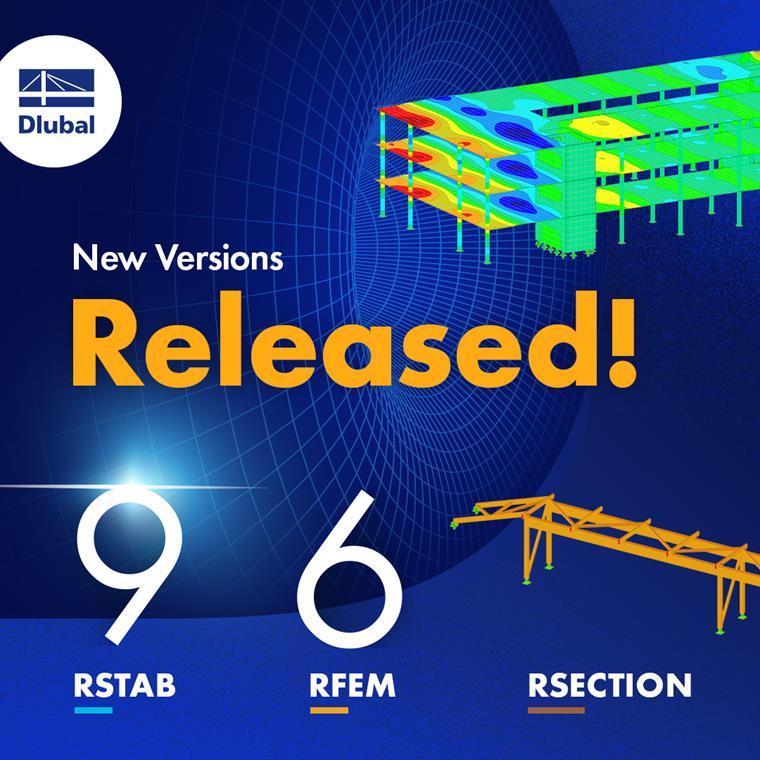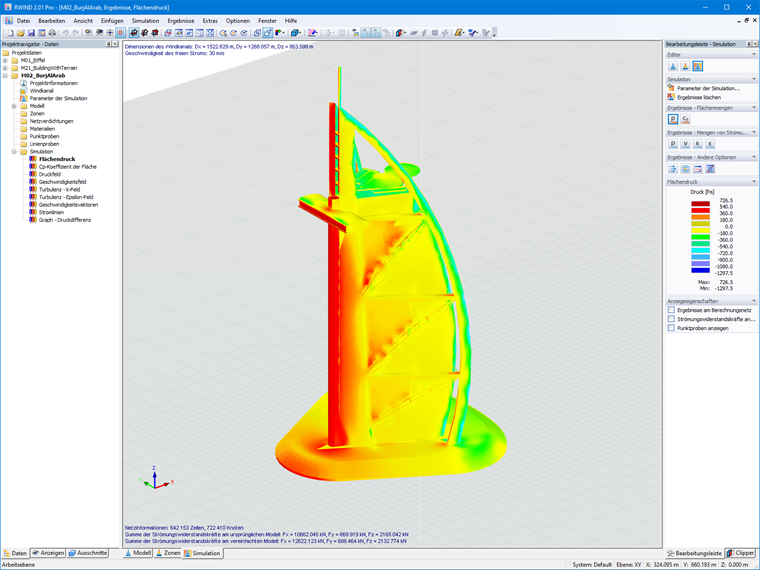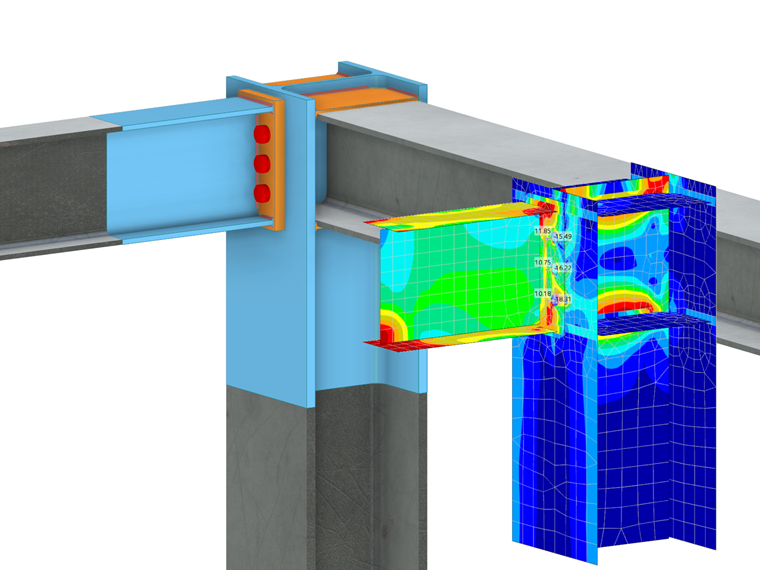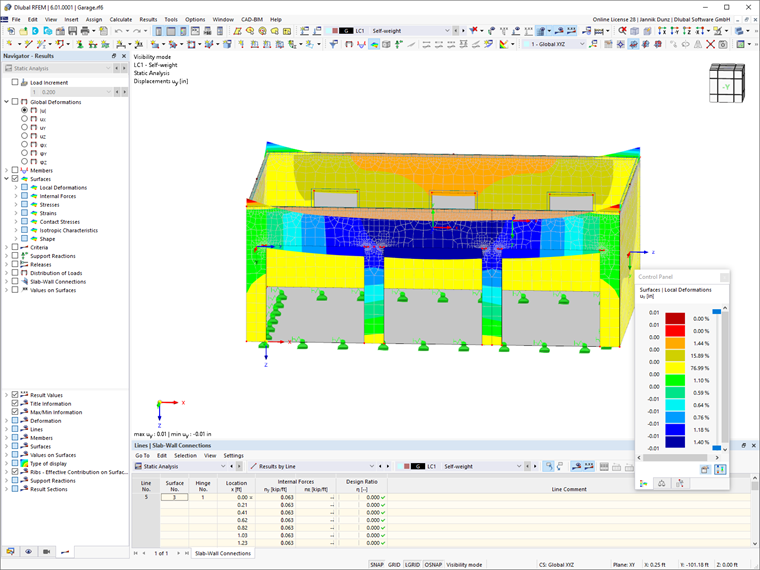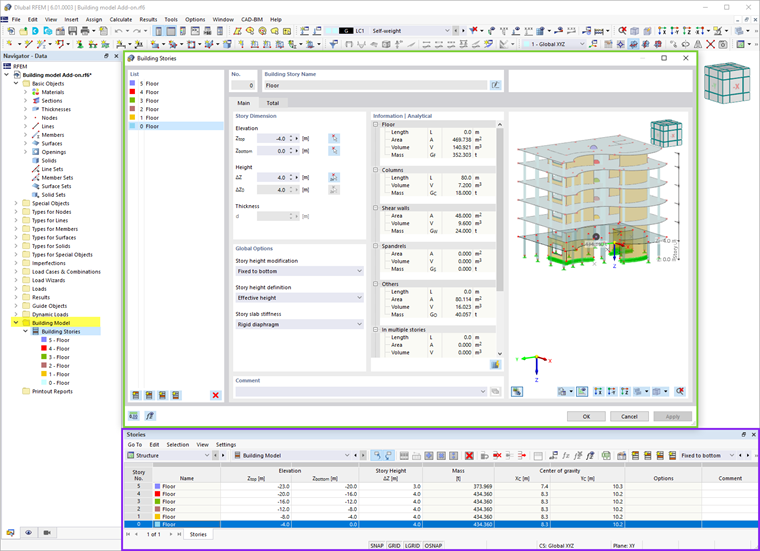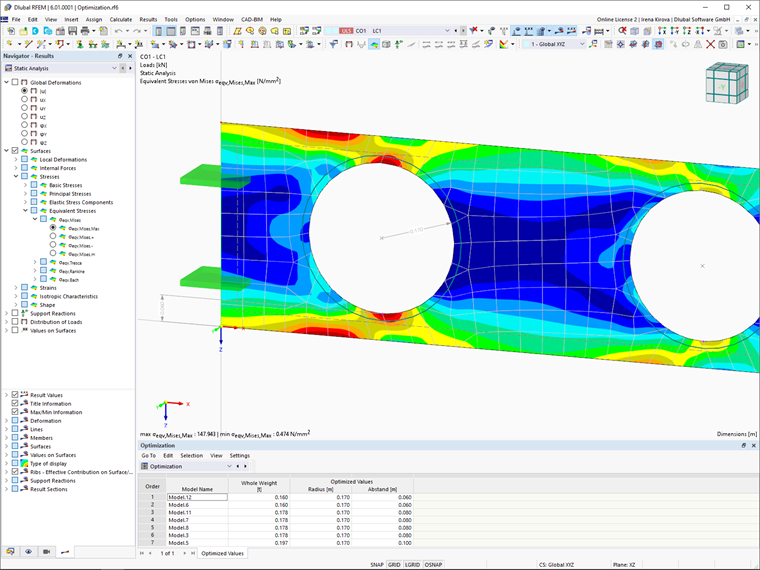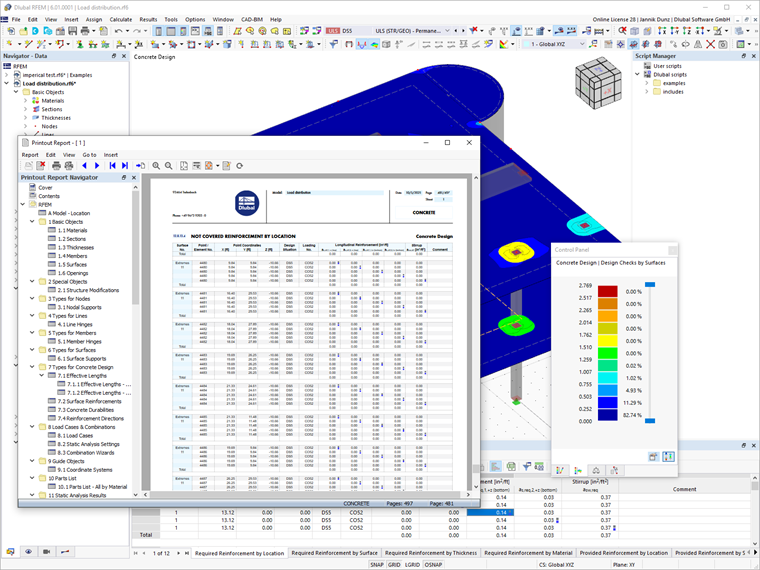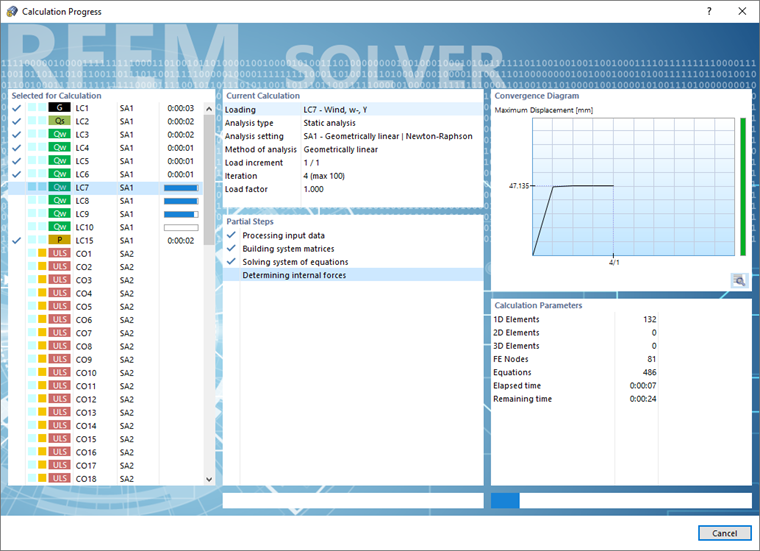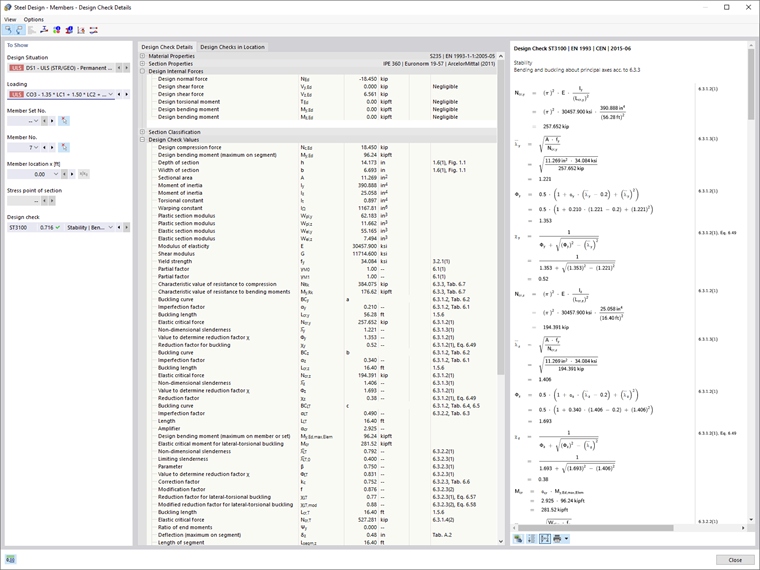New Programs RFEM 6 & RSTAB 9
The RFEM 6 3D FEA program and the RSTAB 9 frame analysis program have been updated extensively and include an intuitive design concept with the add-ons integrated directly in the base program. This leads to a quicker calculation and more efficient design of challenging structures.
The basic program RFEM 6 is used to define structures, materials, and loads for planar and spatial structural systems consisting of plates, walls, shells, and members. The program also allows you to create combined structures as well as to model solid and contact elements. RFEM calculates deformations, internal forces, stresses, support forces, and soil contact stresses.
The frame & truss analysis software RSTAB 9 is suitable for the calculation of 2D and 3D beam, frame, and truss structures made of steel, concrete, timber, aluminum, and other materials. The efficient RSTAB solver allows for linear and nonlinear calculations of internal forces, deformations, and support reactions.
RSECTION
RSECTION combines the previous cross-section programs SHAPE-THIN and SHAPE-MASSIVE. The RSECTION 1 stand-alone program determines the cross-section properties for any thin-walled and solid cross-sections and performs a stress analysis. The graphical and tabular input as well as the input using JavaScript and the DXF file import allows to create various cross-sections very flexibly.
The "Effective Sections" extension for RSECTION determines effective sections according to EN 1993-1-5 [1] and EN 1993-1-3 [2]. With "Effective Sections", for example, the effects of shape instability of cold-formed sections can be taken into account using the eigenvalue method.
RWIND 2
RWIND 2 is a CFD software (digital wind tunnel) for the numerical simulation of wind flows around any building geometries with determination of the wind loads on their surfaces. The determined results can be exported as wind loads to the structural analysis programs RFEM 6 and RSTAB 9. The Pro version now allows the calculation of transient incompressible turbulent wind flows.
New Add-ons
Steel Joints
The Steel Joints add-on for RFEM sets new standards in the calculation and design of steel connections. Steel connections can be analyzed using an FE model. Modeling runs fully automatically in the background and can be controlled by the user via the simple and familiar input of components. The loads determined on the FE model are then used for the design of the components according to EN 1993-1-8 [3] (including National Annexes). The limited analytical design according to the component method allowing only to consider planar internal forces, is now a thing of the past.
Masonry Design
It is a certain milestone in the history of masonry design. It is about the development of a software solution for masonry design, in particular using the FEA method to calculate 3D building models. The Masonry Design add-on for RFEM allows you to design masonry using the finite element method. It was developed as part of the research project "DDMaS - Digitizing the design of masonry structures". The material model represents the nonlinear behavior of the brick-mortar combination in the form of macro-modeling.
Building Model
The Building Model add-on for RFEM is a useful tool for modeling stories. It allows you to define and manipulate a building by means of stories. The stories can be adjusted in many ways afterwards. Information about the stories and the entire model (center of gravity) is displayed in tables and graphics. Furthermore, this add-on can also be used for seismic analysis. Once the spectral analysis has been performed, it is possible to use the Building Model add-on to display story actions, interstory drifts, and forces in shear walls.
Optimization & Costs / CO₂ Emission Estimation
An important trend in the planning of buildings is the topic of optimization and sustainability. The two-part Optimization & Costs / CO₂ Emission Estimation add-on provides an interesting solution for all users in the field of structural optimization. This finds suitable parameters for parameterized models and blocks via the artificial intelligence technology (AI) of particle swarm optimization (PSO) in order to comply with the usual optimization criteria. On the other hand, this add-on estimates the model costs or CO2 emissions by specifying the unit costs or emissions per material definition for the structural model.
WebService and API
There is an increasing need for customized and automated structural analysis and design. This need is met by providing programmable interfaces via Webservice and API. Based on this technology, the programs RFEM 6 and RSTAB 9 provide a server service that can be used locally or via the network. The client-server communication allows you to send requests to and receive feedback from RFEM 6 / RSTAB 9.
The technology of Webservice allows you to create special functionalities quickly and precisely. It allows you to create your own desktop or web-based applications by controlling all objects included in RFEM 6 and RSTAB 9. With access to libraries and functions, you can develop your own designs and effective modeling of parametric structures, as well as optimization and automation processes using the programming languages Python and C#.
New Features
Printout Report
The documentation of structural calculations often takes a lot of time. Therefore, improving the printout report was one of the greatest concerns of our customers. Thanks to the fundamental revision, it is now possible to work in parallel with the program and the report using a non-modal printout report environment. Furthermore, you can interactively modify chapters and create new user-defined chapters. In addition to a modern report design, the import of PDFs, formulas, 3D graphics, and so on, is also possible. An equally important feature is the output of design formulas, which are displayed during the design and refer to the equation from the standard.
Faster Calculation
With increasingly complex structures, the calculation time of the calculation programs increases as well. The calculation kernel of the new structural analysis programs is therefore impressive with the optimized networking and support of multi-processor technology. It enables parallel calculations of linear load cases and load combinations using several processors without additional demands on the RAM: The stiffness matrix only has to be created once. Thus, even large systems can be calculated with the fast direct solver. For models requiring the calculation of multiple load combinations, several solvers (one per core) are initiated in parallel. Each solver then calculates a load combination. This leads to a better utilization of the cores and thus to faster calculations.
Design Formula Output
Structural analysis programs are often like a black box for users. You can counteract this condition by displaying design formulas for reinforced concrete, steel, timber, and aluminum structures, and so on. The design formulas used are displayed in detail and the equation used is indicated in the standard. These design check formulas can also be included in the printout report. As a result, the structural analysis programs are no more a black box, but rather transparent and easy-to-check design tools.
Modern Online Licensing System & Extranet (Dlubal Account)
The flexible use of software applications is especially important in times of COVID-19 and working from home. The modern online licensing system allows you to distribute the licenses of RFEM, RSTAB, and so on all over the world and assign them to the respective users via the Dlubal account. The online licenses can be used from any location, and are not specific to any computer or person. Each registered user in the company can log in with his or her user data. Finally, the old world of hardware dongles is left behind, so that the annoying switching back and forth is no longer necessary.
Tailored information for Dlubal customers is provided by the Extranet being an integral part of the Dlubal website. In this account, every user will find information about company news, events, and products. An overview of the available licenses and products to download is also included. In addition, users can actively participate in the development by submitting desired features or reporting bugs. Each submitted request receives a status so that you can see the current status of your submitted idea at any time.
New Training Opportunities
Access to online training and education is an important aspect to ensure you get the most out of the new program generation RFEM 6, RSTAB 9, RWIND 2 and RSECTION. Therefore, the Dlubal website also provides free online courses for beginners facilitating, for example, the introduction to the FEA program RFEM 6. The website "Structural Analysis Models to Download" also provides a large database of more than 1,000 free structural analysis models that can be used immediately for training purposes.
For passionate podcast listeners, the Dlubal podcast "Digital and Innovative Structures from Civil Engineering" is available. Innovative trends in structural engineering and the future of the construction industry will be discussed. In addition to tragic construction disasters and BIM-based planning tasks, interviews with experts, engineers, and professors from the construction industry often deal with the topics of sustainability and digital issues in the construction industry.
Young engineers and students have always looked to digital education opportunities, and even more so with continued COVID-19 in-person restrictions. Therefore, a varied mix of useful experiences from the daily work of an engineer and the theory learned during studies is also offered on the Infotainment page for this target group. It includes everything from animated and informative examples to easy-to-understand explanations from the construction industry.
Conclusion
A lot has happened at Dlubal Software lately. The release of the new program generation with new add-ons and features is one of the milestones in the history of Dlubal Software. Weekly updates with new features, as well as bug fixes, push the continuous improvement of the programs. The offer of a constantly growing educational platform creates optimal conditions for familiarization with the programs and new structural analysis topics. Thus, structural analysis will be even more fun from now on.
